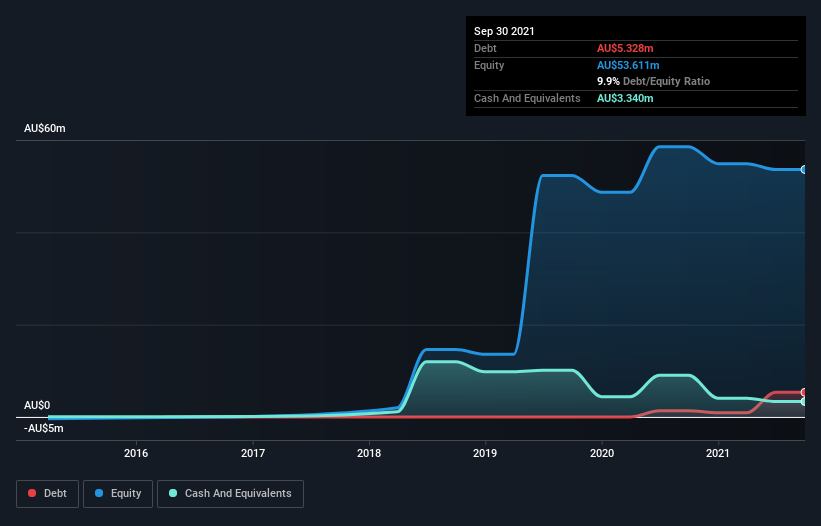
Some say volatility, rather than debt, is the best way to think about risk as an investor, but Warren Buffett famously said that 'Volatility is far from synonymous with risk.' It's only natural to consider a company's balance sheet when you examine how risky it is, since debt is often involved when a business collapses. We can see that Halo Food Co. Limited (ASX:HLF) does use debt in its business. But the real question is whether this debt is making the company risky.
When Is Debt Dangerous?
Debt is a tool to help businesses grow, but if a business is incapable of paying off its lenders, then it exists at their mercy. Part and parcel of capitalism is the process of 'creative destruction' where failed businesses are mercilessly liquidated by their bankers. However, a more common (but still painful) scenario is that it has to raise new equity capital at a low price, thus permanently diluting shareholders. Of course, debt can be an important tool in businesses, particularly capital heavy businesses. The first thing to do when considering how much debt a business uses is to look at its cash and debt together.
View our latest analysis for Halo Food
How Much Debt Does Halo Food Carry?
As you can see below, at the end of September 2021, Halo Food had AU$5.33m of debt, up from AU$1.32m a year ago. Click the image for more detail. On the flip side, it has AU$3.34m in cash leading to net debt of about AU$1.99m.

How Strong Is Halo Food's Balance Sheet?
The latest balance sheet data shows that Halo Food had liabilities of AU$20.8m due within a year, and liabilities of AU$17.6m falling due after that. On the other hand, it had cash of AU$3.34m and AU$11.7m worth of receivables due within a year. So its liabilities total AU$23.3m more than the combination of its cash and short-term receivables.
This is a mountain of leverage relative to its market capitalization of AU$31.5m. This suggests shareholders would be heavily diluted if the company needed to shore up its balance sheet in a hurry. When analysing debt levels, the balance sheet is the obvious place to start. But you can't view debt in total isolation; since Halo Food will need earnings to service that debt. So if you're keen to discover more about its earnings, it might be worth checking out this graph of its long term earnings trend.
In the last year Halo Food wasn't profitable at an EBIT level, but managed to grow its revenue by 36%, to AU$54m. Shareholders probably have their fingers crossed that it can grow its way to profits.
Caveat Emptor
Despite the top line growth, Halo Food still had an earnings before interest and tax (EBIT) loss over the last year. Indeed, it lost a very considerable AU$8.1m at the EBIT level. Considering that alongside the liabilities mentioned above does not give us much confidence that company should be using so much debt. So we think its balance sheet is a little strained, though not beyond repair. Another cause for caution is that is bled AU$8.9m in negative free cash flow over the last twelve months. So in short it's a really risky stock. The balance sheet is clearly the area to focus on when you are analysing debt. But ultimately, every company can contain risks that exist outside of the balance sheet. For instance, we've identified 5 warning signs for Halo Food (2 can't be ignored) you should be aware of.
At the end of the day, it's often better to focus on companies that are free from net debt. You can access our special list of such companies (all with a track record of profit growth). It's free.
Valuation is complex, but we're here to simplify it.
Discover if Halo Food might be undervalued or overvalued with our detailed analysis, featuring fair value estimates, potential risks, dividends, insider trades, and its financial condition.
Access Free AnalysisHave feedback on this article? Concerned about the content? Get in touch with us directly. Alternatively, email editorial-team (at) simplywallst.com.
This article by Simply Wall St is general in nature. We provide commentary based on historical data and analyst forecasts only using an unbiased methodology and our articles are not intended to be financial advice. It does not constitute a recommendation to buy or sell any stock, and does not take account of your objectives, or your financial situation. We aim to bring you long-term focused analysis driven by fundamental data. Note that our analysis may not factor in the latest price-sensitive company announcements or qualitative material. Simply Wall St has no position in any stocks mentioned.
About ASX:HLF
Halo Food
Halo Food Co. Limited, together with its subsidiaries, manufactures dairy, and health and wellness products in Australia, New Zealand, and internationally.
Low and slightly overvalued.
Market Insights
Community Narratives



